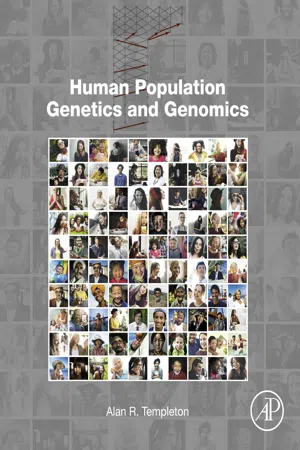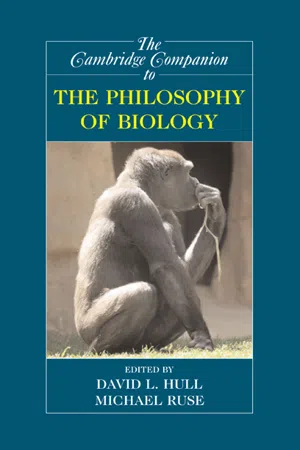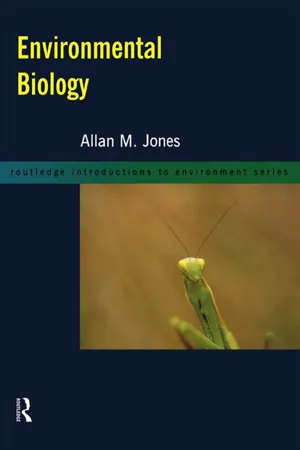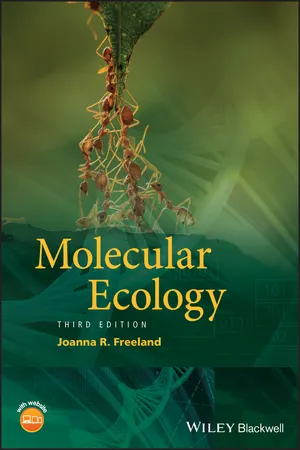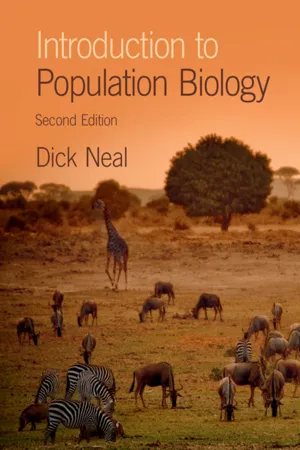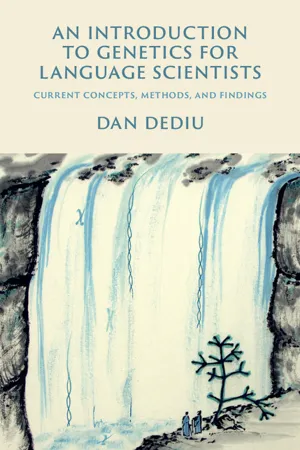Biological Sciences
Population Genetics
Population genetics is the study of genetic variation and its distribution within populations. It explores how genetic traits change over time due to factors like natural selection, genetic drift, and gene flow. By understanding the genetic makeup of populations, population genetics provides insights into evolutionary processes and helps in the conservation of species.
Written by Perlego with AI-assistance
Related key terms
1 of 5
10 Key excerpts on "Population Genetics"
- eBook - ePub
- Alan R. Templeton(Author)
- 2018(Publication Date)
- Academic Press(Publisher)
Chapter 1Definition, Scope, and Premises of Human Population Genetics
Abstract
Population Genetics is the science of genetic variation within populations of organisms. Population Genetics focuses on the origin, amount, frequency, distribution in space and time, and phenotypic significance of that genetic variation, and with the microevolutionary forces that influence the fate of genetic variation in reproducing populations. The extensive theoretical edifice of this field stems from three premises: DNA can replicate, DNA mutates and recombines, and the information in DNA interacts with the environment to produce traits. DNA replication means that a single type of gene can exist in space and time (across generations) beyond any individual who bears the gene. This means that the fate of genes in space and time must be studied at the level of a reproducing population and its associated gene pool—the population of gametes that are the bridges across the generations. Mutation and recombination ensure that the gene pool consists of a variety of genetic types and is the physical basis of all evolutionary change. One of the most important attributes of evolution is adaptation, the acquiring of traits that allow individuals to survive, mate, and reproduce in a particular environment. Adaptation can only occur because the traits emerge from an interaction of genes and environment.Keywords
Bayesian statistics; Evolution; Gene pool; Genotype; Haplotype; Linkage disequilibrium; Maximum likelihood; Mutation; Natural selection; Phenotype; RecombinationPopulation Genetics is the science of genetic variation within populations of organisms. Population Genetics is concerned with the origin, amount, frequency, distribution in space and time, and phenotypic significance of that genetic variation, and with the microevolutionary forces that influence the fate of genetic variation in reproducing populations. Human Population Genetics is specifically concerned with genetic variation in human populations and its evolutionary and phenotypic significance. Although most population genetic principles are broadly applicable to many species, there are many compelling reasons to focus on our own species. First, we are simply interested in ourselves; we are curious about our origins and how we got to be who we are today. Population Genetics can provide insights into the roots of us all. - David L. Hull, Michael Ruse(Authors)
- 2007(Publication Date)
- Cambridge University Press(Publisher)
2 Population Genetics 1. introduction Population Genetics is a subfield of evolutionary biology that aims to represent mathematically the changes in the genetic variation of populations (specifically, sexually reproducing populations with Mendelian heredity) over time. The mathematical models of popu- lation genetics provide a theoretical basis for experimental studies of laboratory populations and studies of natural populations. Our pri- mary focus in this essay is on Population Genetics theory itself, rather than its applications, although towards the end of the essay we give some discussion of the latter. Population Genetics attempts to measure the influence of the causes of evolution, namely, mutation, migration, natural selection, and ran- dom genetic drift, 1 by understanding the way those causes change the genetics of populations. But how does it accomplish this goal? We begin in Section 2 with a brief historical outline of the origins of Population Genetics. In Section 3, we sketch the model theoretic structure of Population Genetics, providing the flavor of the ways in which popu- lation genetics theory might be understood as incorporating causes. In Sections 4 and 5 we discuss two specific problems concerning the relationship between Population Genetics and evolutionary causes, namely, the problem of conceptually distinguishing natural selection from random genetic drift, and the problem of interpreting fitness. In Section 6, we briefly discuss the methodology and key epistemolo- gical problems faced by population geneticists in uncovering the causes of evolution. Section 7 of the essay contains concluding remarks. We are focusing on the issue of causality in Population Genetics because we take this issue to be at the core of many of the 22 roberta l. millstein and robert a. skipper jr. contemporary philosophical debates in Population Genetics.- eBook - ePub
- Allan M. Jones(Author)
- 2006(Publication Date)
- Routledge(Publisher)
PopulationsKey concepts- Genetic variation is related to the method/s of reproduction in a species. Sexual reproduction results in genetic mixing.
- Genetic variation within a population gene pool is the working material for natural selection.
- Inbreeding results in reduced variation within the gene pool while outbreeding increases it.
- Many factors influence the genotypes and gene frequencies of populations and small populations are particularly susceptible.
- Speciation is the result of mechanisms which isolate populations from gene flow.
- Populations of a species occupy a niche but its members are distributed in space (dispersion patterns) and vary in age and size (population structure).
- Environments have a finite carrying capacity (K).
- Populations are subject to both density-dependent and density-independent controls.
- Intraspecific and interspecific relationships are dominated by competition and by predator– prey interactions.
Populations are groups of individuals of the same species living in a defined geographical area. These individuals share many morphological, physiological and behavioural characters but no two individuals are ever exactly the same, although clonal forms produced by asexual reproduction or parthenogenesis will be extremely similar. Even genetically identical individuals may vary due to differences arising during growth and development. It is this variation that provides the raw material for natural selection. The aim of this chapter is to describe and discuss the characteristics of populations and the parameters, both internal and external, which exert control upon them.6.1 Ecological geneticsNatural selection - eBook - ePub
- Joanna R. Freeland(Author)
- 2019(Publication Date)
- Wiley(Publisher)
It should be apparent from the preceding examples that population boundaries are seldom precise, although in many cases should correspond more or less to the distribution of potential mates. When beginning a research project, biologists often identify discrete populations as part of the framework they are using for their sampling design, which should specify parameters such as the minimum number of individuals that need to be sampled from each presumed population. Nevertheless, populations are not necessarily clear‐cut units, and the boundaries are sometimes revised after additional ecological or genetic data have been acquired. Bearing in mind that molecular ecology is primarily concerned with wild populations, which by their very nature are variable and often unpredictable, we shall now start to look at ways in which molecular genetics can help us to understand the dynamics of single populations.Quantifying Genetic Diversity
The genetic diversity of a population refers to the numbers of different alleles that are collectively contained within all individuals, and is one of the most important attributes of any population. Environments are constantly changing, and diversity is necessary if populations are to continuously evolve and adapt to new situations. This is intuitively obvious, because evolution can act only on existing levels of variation. It should therefore not be surprising to learn that a link between genetic diversity and the resilience of populations has been made in numerous quantitative studies. For example populations of the threatened, predominantly clonal seagrass Posidonia australis with relatively high levels of genetic diversity also had relatively high levels of variation in morphological traits and shoot productivity (Evans et al. 2016 ). Meadows of another clonal seagrass, Zostera noltii, with relatively high levels of genetic diversity were better able to resist environmental perturbations than meadows that harbored low levels of diversity (Massa et al. 2013 ). More generally, a review of 31 experimental and 14 comparative studies across a range of taxonomic groups found that populations and species with relatively high levels of genetic variation were less vulnerable to environmental change and less prone to extinction. In addition, they had more stable population sizes, experienced greater success in establishing new populations, and had larger geographic distributions (Forsman and Wennersten 2016 ). The genetic diversity of populations can also directly affect the communities and ecosystems in which they live. Fourtune et al. (2016 ) used a combination of electric‐fishing and microsatellite genotyping to determine that the species diversity of a fish community was correlated with genetic diversity in each of four freshwater fish species (so‐called species–genetic diversity correlations , or SGDCs ), a pattern that is likely explained by a combination of historical process (e.g. colonization histories) and current environmental conditions. In Chapter 8 - Available until 20 Nov |Learn more
- Mark Stoneking(Author)
- 2016(Publication Date)
- Wiley-Blackwell(Publisher)
CHAPTER 3 Genes in PopulationsHaving covered how genes are inherited, as well as what they are, what they do, and how they do it, we are now ready to tackle how genes behave in populations. In case you are wondering, understanding how genes behave in populations is necessary for understanding how evolution influences genes, which in turn is important for trying to infer what happened in the past from patterns of genetic variation in populations living today—which is, to remind you, a major goal of molecular anthropology. So, in this chapter we will cover some important concepts about populations, while the next two chapters will discuss how genes behave in populations, and the various evolutionary forces and how they influence genetic variation within populations and genetic differences between populations. From an historical perspective, all of this information could have come before the preceding chapter on molecular genetics, because all of the ideas and concepts about genes in populations and how their variation is influenced by evolutionary forces were worked out long before anyone knew what a gene actually was. However, knowing something about what genes are does aid in understanding the ideas and concepts presented in this and subsequent chapters.What is a Population?
As we shall see in later chapters, many of the analyses that molecular anthropologists carry out are performed on data collected from populations. A critical aspect of these analyses, that often does not get enough attention, is determining who belongs to which population. So, let's start by defining what we mean by a population. Here is the scientific definition of the term “population”: a spatial–temporal group of interbreeding individuals who share a common gene pool. This is a great example of how scientists like to do things: take a word for which everyone has at least some idea of the meaning (like “population”) and define it with terms that nobody ever uses! But let's break down the terms and see what is going on. First, what is meant by “spatial–temporal”? Simply that a population occupies a particular geographic area (the spatial) and does so over a (relatively) long period of time (the temporal). So, assuming that you are reading this book because it is an assigned text for a particular class, we wouldn't consider you and your classmates to be a population, because even though you assemble regularly at one specific location (viz., the classroom or lecture hall), after class is over you disperse to other locations. - eBook - PDF
- Joanna R. Freeland(Author)
- 2020(Publication Date)
- Wiley(Publisher)
Quantifying Genetic Diversity The genetic diversity of a population refers to the numbers of different alleles that are collectively contained within all individuals, and is one of the most important attributes of any population. Environments are constantly changing, and diversity is necessary if populations are to continuously evolve and adapt to new situations. This is intuitively obvious, because evolution can act only on existing levels of variation. It should there- fore not be surprising to learn that a link between genetic diversity and the resilience of populations has been made in numerous quantitative studies. For example populations Figure 5.2 Pollinators such as this bee influence plant population boundaries because they distribute male gametes (pollen) and therefore help to determine which plants interbreed. Source: Photo by Jon Sullivan. Molecular Ecology 152 of the threatened, predominantly clonal seagrass Posidonia australis with relatively high levels of genetic diversity also had relatively high levels of variation in morphologi- cal traits and shoot productivity (Evans et al. 2016). Meadows of another clonal sea- grass, Zostera noltii, with relatively high levels of genetic diversity were better able to resist environmental perturbations than meadows that harbored low levels of diversity (Massa et al. 2013). More generally, a review of 31 experimental and 14 comparative studies across a range of taxonomic groups found that populations and species with relatively high levels of genetic variation were less vulnerable to environmental change and less prone to extinction. In addition, they had more stable population sizes, experi- enced greater success in establishing new populations, and had larger geographic distri- butions (Forsman and Wennersten 2016). The genetic diversity of populations can also directly affect the communities and ecosystems in which they live. - eBook - PDF
- Narendra S. Goel, Nira Richter-Dyn(Authors)
- 2013(Publication Date)
- Academic Press(Publisher)
7 Population Genetics In the preceding three chapters, we modeled the dynamics of a population with interactions either within the population (Chapter 4) or with populations of other species (Chapters 5 and 6). The individuals constituting a population were regarded as identical, and their number characterized the state of the population. To investigate the population more precisely, one has to consider the structure of the population at a somewhat microscopic scale by taking into account the differences among the individuals of the same species. The two main structural features of the population are its age distribution and genetic consitution. In this chapter we attempt to study the genetic consitution and changes in it as the population evolves, by using the mathematical analysis of stochastic processes presented in this monograph. The study of this subject started with Mendel and has since been carried out very extensively. There exists a large amount of literature on the subject and, in this book, we can only discuss and review the most important factors underlying genetic processes and demonstrate how the general theory of Chapter 3 leads to a quantitative understanding of these processes. A list of references is given at the end of the 144 Population Genetics 7 chapter where a more detailed treatment of this subject can be found. We will assume that the reader is familiar with the basic Mendelian genetics. If he is not, he can easily familiarize himself by reading an elementary monograph on gentics, e.g., that by Barish (1965). In a single species, the number of different possible genotypes 1 far exceeds the number of individuals, since the individual genotype is determined by a large number of genes, many of which have more than one possible form (allele). Therefore, it is impossible to study the number of individuals in each genotype group. Instead, the investigation is carried out by considering the number of genes of the same allele in the population. - eBook - ePub
Insect Resistance Management
Biology, Economics, and Prediction
- David W. Onstad(Author)
- 2013(Publication Date)
- Academic Press(Publisher)
Thompson (1994) , the coevolutionary dynamic of interacting species may differ from one population to the next, with selection favoring some traits in one environment and different traits in another environment. Overlaid on these contrasting selective pressures is gene flow among populations. Such evolutionary complexity, which lies outside the textbook description of a single selective force acting on a single population, is also often operating in agricultural systems. In these systems, different populations of a pest are confronted with differing management practices, but these populations are connected by some level of gene flow. Furthermore, standing genetic variation is also a dynamic condition over time due to mutation, pleiotropic effects of resistance genes, and general environmental dynamics.Our desire for simplicity causes scientists to arbitrarily choose a gene pool at a given time as representing the standing level of genetic variation. The choice of a reference time is arbitrary, as is the practical need to disregard variation due to alleles at frequencies that are either below a typical mutation rate or too low to sample in empirical research. For example, if we assume that genetic variation in resistance to a toxin is normally distributed in a population, then from basic statistical theory we know that 3×10−5 of this variation is not included in studies that truncate a population at four standard deviations above the mean. Is this small proportion of the gene pool part of the standing genetic variation or not? Only when we truncate the distribution beyond five standard deviations above the mean do we include all mutations and variation occurring at frequencies higher than a typical neutral substitution rate (4×10−9 according toffrench-Constant et al . (2004)). If the purpose of evolutionary biology concerning resistance is the study of rare genes and events, then it is unwise to form a habit of simplifying the genetic variation in a population.Karasov et al . (2010)challenged the dogma concerning mutation rate and effective population size in studies of natural selection in arthropod populations. It is generally assumed that adaptation by arthropods is limited by the population-level mutation rate, which is proportional to the product of effective population size multiplied by the per-site mutation rate given the standing neutral variation.Karasov et al. (2010)observed that multiple simple and complex resistance alleles (at insecticide resistance locus Ace) evolved quickly and repeatedly within individual populations of D. melanogaster . They concluded that, contrary to dogma, short-term, effective population sizes existing during adaptation due to selection by insecticides (10–1000 generations) are essentially the same as observed population sizes (circa 108 ).Karasov et al. - eBook - PDF
- Dick Neal(Author)
- 2018(Publication Date)
- Cambridge University Press(Publisher)
We can conclude that all individuals in the population are genetically unique, except in the rare case of identical twins where the zygote has split into two during development. Even here, epigenetic modifications of gene expression as individuals age mean that their gene expressions are not quite identical (see Chapter 8, Section 8.3.3). We would reach the same conclusion for most sexually reproducing organisms, and so we can think of such populations as being made up of an infinite variety of genetically unique individuals. In the next chapter , however, we will see how a small popula- tion size can have a profound effect on the level of genetic variability. 154 Mutation and the Genetic Variation of Populations 10.6 Summary and Conclusions Mutations change the sequence of bases in the DNA molecule, and this may lead to a change in phenotype. Mutations are random with respect to the needs of the organism, and so may be favourable, neutral or disadvantageous in terms of selection. Mutation rates are extremely low, in the order of 1 in 10 000 to 1 in 10 billion (10 9 ) per cell per replication, and consequently they can only cause extremely slow changes in the characteristics of populations unless aided by some other force, such as selection. Only those mutations that are in the germ line, i.e. those that are transmitted from one generation to the next, have the potential to influence evolution. Almost all populations contain a large amount of genetic variation. Typically, 5–15 per cent of the genes in an individual are heterozygous, with the result that no two gametes will be genetically identical and so in most sexually reproducing populations, all the individuals are genetically unique. At the population level, typically 20–60 per cent of the genes are poly- morphic, and this huge reservoir of genetic diversity means that populations can respond genetically to adapt to changes in the environment. - eBook - PDF
An Introduction to Genetics for Language Scientists
Current Concepts, Methods, and Findings
- Dan Dediu(Author)
- 2015(Publication Date)
- Cambridge University Press(Publisher)
Therefore, it is not intended to be a general introduction to these topics as there are many excellent textbooks such as Halliburton (2004) and Jobling et al. (2013), nor does it cover all possible aspects or go into great depth, but instead tries to sample a selection of relevant topics, with an accent on recent developments that might help shed light on language evolution and change. 160 8.1 Foundations of Population Genetics 161 8.1 Foundations of Population Genetics: loci, alleles, individuals and populations Until now, we have focused on the molecular aspects of our genome, on how it influences the phenotype and on some of the methods used to find and study such influences. However, individuals are embedded within populations and it is to the populations and their dynamics through space and time that we now turn our attention. From a very abstract point of view, populations are composed of similar individuals, each individual having a genome that can be usefully reduced to a set of loci, each copy of the locus being occupied by one of a set of possible alleles. For example, we might focus on a single autosomal locus that has two alle- les, denoted A and a; therefore, each individual’s genotype at this locus can be either AA, aa (both known as homozygous) or Aa (heterozygous – please note that it is usually assumed that the genotypes Aa and aA are equivalent). Thus, a population with nine individuals might be composed of two homozy- gous aa, five heterozygous aA, and two homozygous AA (see Figure 8.1). In this case, the proportion (or frequency) of aa individuals in the population is p aa = 2 9 ≈ 0.22 = 22%, that of aA individuals is p aA = 5 9 ≈ 0.55 = 55%, and that of AA individuals is p AA = 2 9 ≈ 0.22 = 22%. Please note that the sum of the genotype frequencies of all genotypes present in the population (with possible but absent genotypes having a frequency of 0%) equals 100% (here, p aa + p aA + p AA = 2 9 + 5 9 + 2 9 = 9 9 = 1 = 100%).
Index pages curate the most relevant extracts from our library of academic textbooks. They’ve been created using an in-house natural language model (NLM), each adding context and meaning to key research topics.
